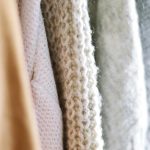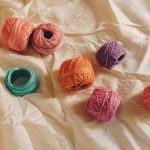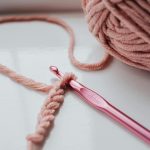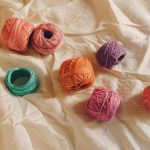Pilling on bed sheets is mainly caused by friction between your body and the fabric, especially if your sheets are made from low-quality materials. When fibers weaken, they tangle and form those annoying little balls. Using high-quality sheets, washing them in cold water on gentle cycles, and avoiding fabric softeners can help you prevent pilling. Plus, adjusting your sleep habits to reduce friction makes a difference. You’ll discover even more tips to keep your sheets looking fresh and new.
Table of Contents
Key Takeaways
- Pilling is caused by friction between sheets and the body during sleep, worsened by tossing and turning.
- Choose high-quality materials like 100% cotton or bamboo to reduce the risk of pilling.
- Wash sheets in cold or warm water on gentle cycles to maintain fiber integrity and minimize pilling.
- Avoid using fabric softeners, as they can break down fibers and contribute to pilling over time.
- Implement regular maintenance, such as cleaning bedding and air-drying, to extend the lifespan of your sheets and reduce pilling.
Understanding Pilling: What It Is and Why It Happens
When you notice those little balls of fuzz forming on your bed sheets, it’s easy to wonder what causes this annoying phenomenon known as pilling.
Pilling occurs when fabric fibers loosen and tangle together, creating those pesky clusters. This often happens due to the type of material used; for instance, synthetic fibers like polyester are more prone to pilling than natural fibers.
Additionally, wear and tear from regular use and washing can lead to fraying. The age of your sheets can also play a role, as older fabrics may be more susceptible.
It’s important to understand that pilling doesn’t reflect the quality of your sheets but rather the nature of the materials and care they receive.
The Role of Friction in Pilling
When you move in your sleep, the constant friction between your body and the sheets can lead to pilling.
The skin on your feet, in particular, may create additional wear as you shift around.
Plus, the type of mattress you have can further impact how much friction your sheets experience, contributing to those pesky pills.
Sleep Movement Effects
Although you mightn’t notice it while you sleep, the movements you make during the night can markedly contribute to pilling on your bed sheets.
Every twist and turn creates friction between your skin and the fabric, leading to tiny fibers breaking loose. Here’s how your sleep movement affects pilling:
- Rolling Over: Frequent rolling can cause increased friction, especially on lower-quality sheets.
- Tossing and Turning: If you change positions often, it intensifies the wear and tear on the fabric.
- Repositioning: Adjusting your covers or pillows can also add to the friction, resulting in more pilling.
Being mindful of your sleep habits and using high-quality sheets can help reduce this unwanted wear.
Foot Skin Friction
While you may not realize it, the friction between your feet and the sheets plays a significant role in pilling. Each time you move in bed, your skin rubs against the fabric, generating friction. This constant rubbing can loosen the fibers in your sheets, causing them to form those pesky little pills.
If you sleep with bare feet or wear rough socks, you might increase this friction further, leading to even more pilling. To minimize this effect, consider wearing smoother, softer sleepwear or using higher-quality sheets designed to resist pilling.
Regularly washing your sheets with gentle detergents can also help maintain their integrity, reducing the friction that leads to those annoying little fuzz balls.
Mattress Impact on Sheets
The surface of your mattress can greatly influence how your sheets wear over time. The friction created between your sheets and mattress plays an essential role in pilling.
If you want to minimize this issue, consider the following:
- Mattress Material: A softer mattress can reduce friction, while a firmer one may cause more wear on your sheets.
- Mattress Protector: Using a smooth, breathable mattress protector can create a barrier, reducing direct contact and friction.
- Sheet Quality: Opt for high-quality bed sheets made from durable materials, as they’re less prone to pilling despite friction.
Impact of Low-Quality Materials on Fabric
When you choose bed sheets made from low-quality materials, you’re often setting the stage for pilling and a shorter lifespan of the fabric.
Low-quality fibers tend to be weaker and less durable, making them more prone to fraying and breaking down over time. This deterioration leads to those annoying little balls of fuzz, known as pills, which can accumulate on the surface.
Additionally, sheets made from synthetic materials or blends may lack the breathability and comfort of higher-quality fabrics, affecting your sleep quality.
Investing in better materials not only enhances your bedding experience but also reduces the chances of pilling, ensuring a smoother, more comfortable surface night after night.
Prioritize quality to enjoy long-lasting, luxurious sheets.
High Washing Temperatures and Their Effects
Although you might think that washing your bed sheets in hot water guarantees they’re thoroughly clean, high washing temperatures can actually contribute to pilling.
The heat can weaken the fibers in your sheets, making them more prone to fraying and creating those annoying little balls of fabric.
To prevent this from happening, consider these tips:
- Wash in Cold or Warm Water: Use cold or warm water settings instead of hot to maintain fiber integrity.
- Gentle Cycle: Choose a gentle wash cycle to reduce agitation, which can lead to pilling.
- Avoid Overloading: Don’t overload your washing machine; give sheets enough space to move freely.
Weave Methods and Their Influence on Pilling
High washing temperatures aren’t the only factor that can lead to pilling on your bed sheets; the weave method also plays a significant role.
Different weaves, like percale and sateen, affect how fibers interact with each other. Percale, with its tighter, crisp finish, typically resists pilling better than sateen, which has a softer, silkier feel. The loose structure of sateen can cause fibers to rub against each other more, leading to pilling over time.
If you want to minimize pilling, consider choosing sheets with a tighter weave. Additionally, avoid sheets made with lower-quality fibers, as they’re more prone to pill.
The Importance of Fabric Quality
While it might be tempting to choose bed sheets based solely on their appearance or price, the quality of the fabric plays an essential role in their durability and comfort.
High-quality sheets not only feel better against your skin, but they also last longer without developing issues like pilling. Here are three key factors to evaluate:
- Fiber Type: Natural fibers, like cotton or linen, tend to be more durable and breathable compared to synthetic options.
- Thread Count: A higher thread count often indicates better quality, leading to softer and more resilient sheets.
- Finishing Processes: Quality sheets undergo careful finishing processes, reducing the likelihood of pilling and enhancing their overall feel.
Investing in quality fabric will ultimately pay off in sleep comfort and longevity!
Effective Prevention Strategies for Pilling
To keep your bed sheets looking fresh and free from pilling, implementing a few effective prevention strategies is essential.
First, choose high-quality materials like cotton or linen, as they resist pilling better than synthetic fabrics.
When washing your sheets, use a gentle cycle with cold water to minimize friction. Avoid overloading the washing machine, which can lead to excessive rubbing.
Using a fabric softener can also help reduce static and friction. Always separate your sheets from rough items like towels or jeans to prevent abrasion.
Finally, consider air-drying your sheets or using a low heat setting in the dryer to lessen wear.
Maintenance Tips for Extending Sheet Lifespan
Maintaining your bed sheets properly can greatly extend their lifespan and keep them looking fresh. Here are some essential tips to guarantee your sheets last longer:
- Wash with Care: Use a gentle cycle with cold water and mild detergent. This helps prevent wear and tear on the fabric.
- Avoid Fabric Softeners: While they may smell nice, fabric softeners can break down fibers over time, leading to pilling.
- Dry on Low Heat: High heat can damage the fibers, so opt for a low heat setting or air dry your sheets to maintain their quality.
Adjusting Sleeping Habits to Reduce Friction
To keep your bed sheets looking fresh, you might want to rethink your sleeping habits.
Adjusting your sleep position, enhancing mattress comfort, and choosing the right fabric can all help reduce friction that causes pilling.
Sleep Position Adjustments
While you mightn’t realize it, the way you sleep can greatly impact the longevity of your bed sheets. The friction created during your slumber can lead to pilling, which shortens the life of your linens.
Here are some sleep position adjustments you can try:
- Switch to Your Back: Sleeping on your back minimizes contact with the sheets, reducing friction that causes pilling.
- Use a Silk Pillowcase: If you prefer sleeping on your side, a silk pillowcase can decrease friction against your sheets.
- Avoid Tossing and Turning: Practice relaxation techniques to reduce movement during sleep, which can also help prevent pilling.
Making these adjustments can preserve the quality of your bed sheets, ensuring they stay soft and smooth for longer.
Mattress Comfort Enhancement
Enhancing mattress comfort can greatly reduce friction between your body and bed sheets, ultimately minimizing pilling.
Start by evaluating your mattress type; a medium to plush feel often provides better cushioning. Consider adding a mattress topper for an extra layer of comfort, which can help absorb movement.
Pay attention to your sleeping position, too. If you tend to shift around a lot during the night, aim for a more stable position to lessen friction.
Finally, keep your bedding clean and fresh. Regular washing removes debris that can contribute to pilling.
Fabric Choice Considerations
Choosing the right fabric for your bed sheets plays an essential role in reducing pilling and enhancing your sleep experience.
To minimize friction and prolong the life of your sheets, consider these fabric options:
- 100% Cotton: Look for long-staple or Egyptian cotton, which is less prone to pilling and feels luxurious against your skin.
- Bamboo: This eco-friendly option is naturally smooth and breathable, helping to reduce friction and keep you comfortable all night.
- Microfiber: While affordable, make sure you choose high-quality microfiber, as it can resist pilling better than lower-grade alternatives.
Frequently Asked Questions
Can Pilling Be Removed From Sheets, and How?
You’ve noticed those pesky pills on your sheets, haven’t you? To remove them, simply use a fabric shaver or a lint roller. With a little effort, you’ll bring back the smoothness you love.
How Often Should I Wash My Bed Sheets?
You should wash your bed sheets every one to two weeks. If you sweat a lot or have allergies, consider washing them weekly. Regular cleaning keeps them fresh and helps maintain their longevity.
Are Certain Colors More Prone to Pilling?
Certain colors aren’t inherently more prone to pilling, but darker shades can show it more easily. You’ll want to choose high-quality materials and follow care instructions to minimize any pilling, regardless of color.
Do Pillowcases Experience Pilling Like Sheets Do?
Pillowcases can be like soft clouds, but yes, they can experience pilling just like sheets. To minimize this, choose high-quality fabrics and wash them gently to keep them smooth and fluffy for longer.
What Types of Fabrics Are Least Likely to Pill?
You’ll find that fabrics like silk, polyester, and tightly woven cotton are least likely to pill. Choosing these materials can help maintain your bedding’s appearance and feel, making your sleep experience more enjoyable and comfortable.
- A Beginner’s Guide to Nonwoven Fabric Types - July 11, 2025
- Spunbond vs. Spunlace: What’s the Difference in Nonwoven Fabrics? - July 11, 2025
- The Ultimate Comparison: Woven vs. Nonwoven Fabric Properties - July 11, 2025






